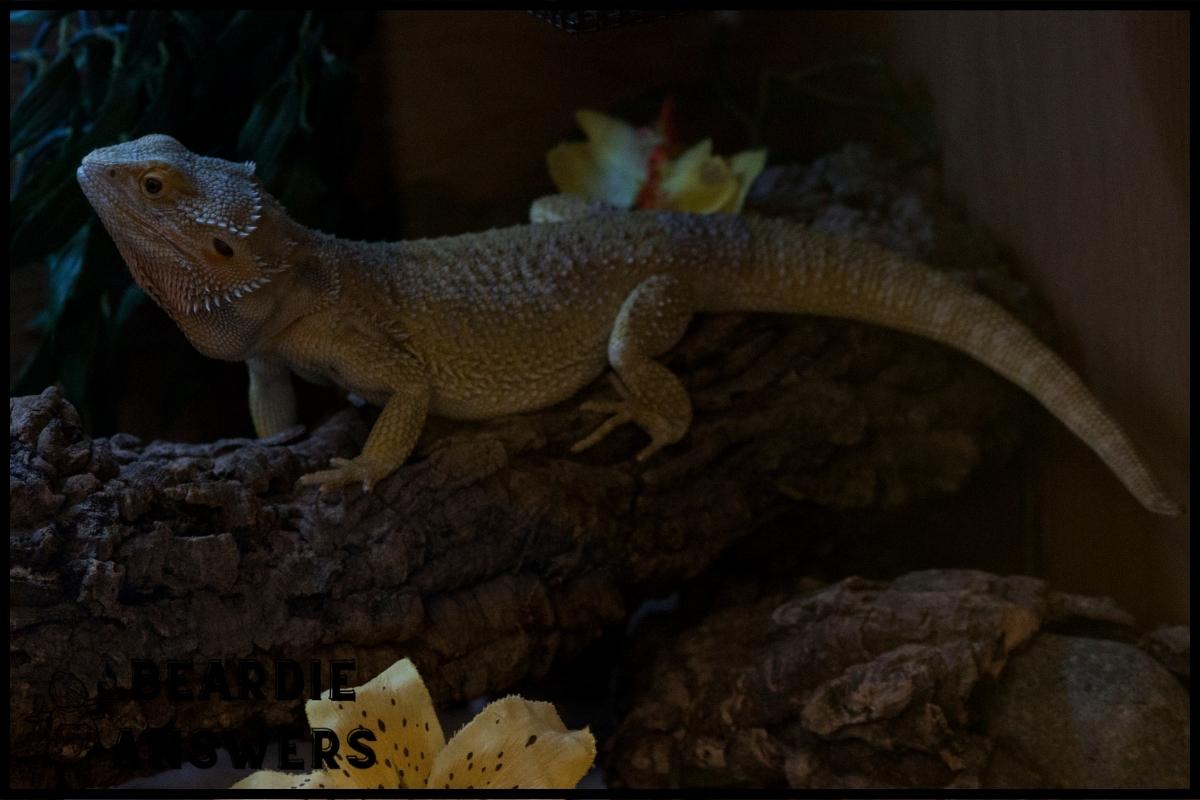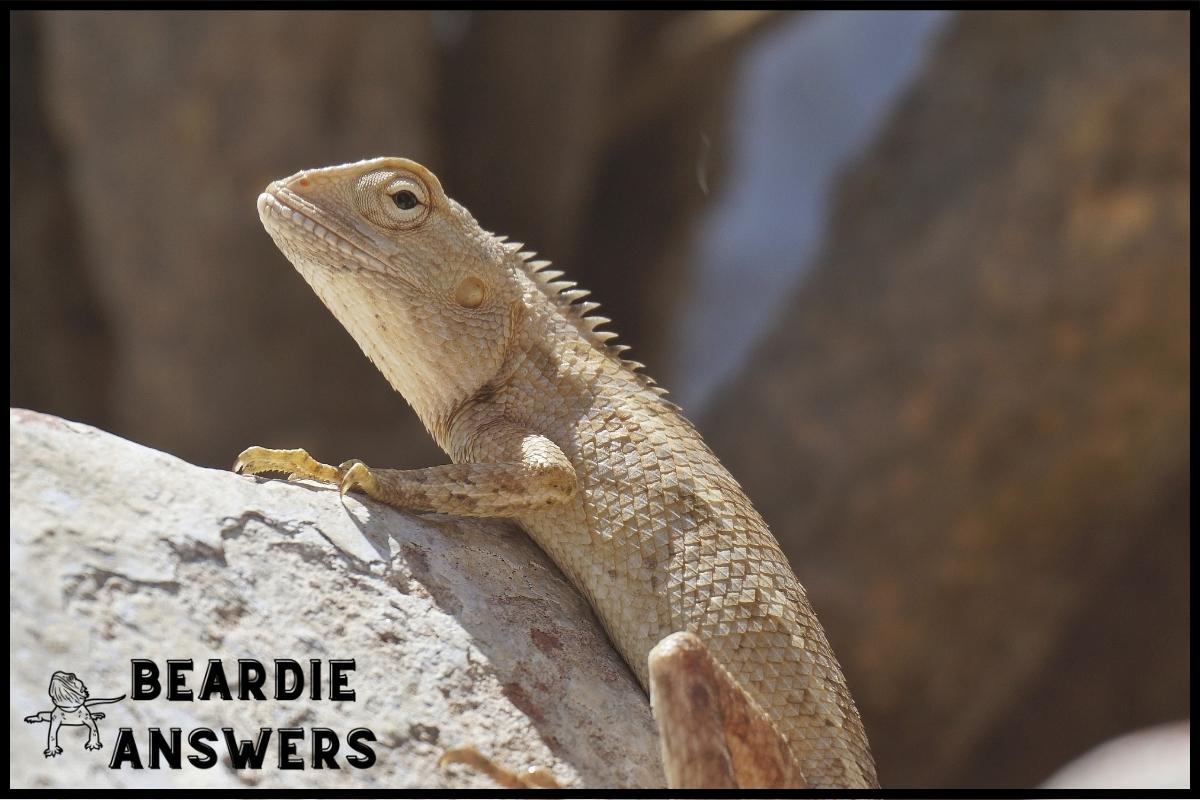[su_note note_color=”#eee”]
A 6-month-old bearded dragon is still considered a juvenile and requires a balanced diet and proper nutrition. They should be fed 2-3 times a day, with a variety of insects, vegetables, and fruit to support their growth and development.[/su_note]
Bearded dragons are amazing pets, and they’re especially popular among reptile-lovers. At six months old, these lizards are still considered juveniles and need specialized care to ensure their health and happiness.
For example, it’s important to know that a 6-month bearded dragon should be fed 2-3 times per day in order for them to get the nutrition they need for growth.
In this article, we’ll discuss the specifics of caring for a 6 month bearded dragon so you can provide your scaly friend with all the love he or she needs!
What You'll Learn
6 Month Bearded Dragon – A Brief Overview
The 6-month bearded dragon is an exciting pet to own, and with the right care they can live long healthy lives. They are gentle reptiles that have become increasingly popular in recent years.
Picture yourself basking in a warm sunlit enclosure – this could be your new reality when you bring home a 6 month old bearded dragon!
When caring for these animals it’s important to understand their specific needs which include:
- Housing requirements
- Temperature regulation
- Handling tips
- Enclosure setup
- UVB lighting
Setting up the perfect environment for them is key; not only should their enclosures replicate the natural habitat of a desert but also give them plenty of space to move around comfortably.
Ensuring that temperatures stay consistent throughout the day by providing specialized bulbs such as UVA/UVB lights will help keep them happy and energized. Handling your pet with caution and respect is essential too; support their body from underneath while avoiding direct contact with their head or tail.
With all these considerations kept in mind, owning a 6-month beardie will no doubt be an enjoyable experience both for you and your reptile companion.
Characteristics Of A 6 Month Bearded Dragon
At 6 months of age, bearded dragons are considered juveniles. They have many distinct characteristics, including socializing behavior, temperature needs, shedding habits, and handling tips.
Bearded dragons are very social creatures and may become stressed when left alone for too long; they should therefore be housed with other friendly reptiles or handled often to prevent anxiety.
In addition to personality, their temperatures need to stay within a specific range in order to survive; if the environment is too cold or hot, this could lead to serious health risks.
Shedding can occur every few weeks depending on the dragon’s growth rate; during these times it’s important to provide plenty of warm water baths which will help soften any stuck skin.
Lastly, whenever handling a juvenile bearded dragon it’s best to use slow movements as sudden motions can cause fear.
The habitat setup for a 6 month old beardie needs to reflect its size and lifestyle; an enclosure between 40-55 gallons is usually recommended and should include climbing branches along with surfaces that absorb heat from basking lights properly.
Appropriate Environments For A 6 Month Bearded Dragon
Bearded dragons are incredibly popular reptiles that can make wonderful and engaging pets. According to the American Veterinary Medical Association, more than two million households in the United States owned a reptile or amphibian as of 2016.
Caring for a 6 month old bearded dragon requires providing an appropriate environment with housing requirements, temperature control, lighting needs, substrate choices, calcium supplementation, and health monitoring.
In terms of housing requirements, it is important to provide enough space for the dragon to move around freely while still allowing them to feel secure. Tanks should be at least 20 gallons with larger tanks being preferred if available. They also need access to hide spots so they have places to escape from light sources used during basking times. It is also important that these enclosures are kept clean by spot cleaning daily and doing weekly deep cleanses.
Temperature control and lighting needs are vital components when caring for a 6 month old bearded dragon. The enclosure must contain both hot (90-95°F) and cool (75-80°F) sides separated by a gradient zone where temperatures range between 85-90°F throughout the day.
A 40 watt incandescent bulb should be placed near one side of the tank to maintain this warmth necessary for digestion and proper growth. In addition, UVB lighting should be installed over the entire length of the enclosure approximately 12 inches away from your pet’s basking sites which helps regulate metabolic processes like vitamin D synthesis essential for calcium absorption.
Substrate choice is very important because some materials can cause impaction such as wood chips or sand but there are certain substrates you can use safely including tile flooring or paper towels which will help keep their habitat clean until they reach 18 months old when it is safer to switch over to something like ReptiCarpet or EcoEarth coconut fiber bedding material.
Lastly, considering calcium supplementation is key as well since young dragons require additional vitamins and minerals especially calcium due to rapid growth spurts during this stage in life; supplementing 3 days per week using products formulated specifically for reptiles is recommended until adulthood has been reached at about 2 years old after which 1x/week would suffice depending on diet intake of other nutrient dense foods like dark leafy greens along with insects like crickets or dubia roaches.
With all these environmental factors considered then we can look towards what type of diet a six month old bearded dragon may benefit from…
Diet Of A 6 Month Bearded Dragon
Protein sources for a 6 month bearded dragon can include mealworms, crickets, and waxworms. Insects should be gut-loaded with nutritious vegetables and then dusted with calcium powder to provide important vitamins and minerals. Vegetables should make up a large portion of the diet, with leafy greens like collard greens, mustard greens, and dandelion greens being especially beneficial.
Protein Sources
Protein is a key component in the diet of a 6 month old bearded dragon, and should be obtained through both natural prey items and enriched foods.
Prey items such as crickets, mealworms and wax worms are great sources of protein for your pet beardie.
Additionally, commercial diets like pellets or frozen vegetables can also provide them with their daily dose of nutrients.
Protein-rich fruits such as blueberries and raspberries can also be added to their meals occasionally as a treat!
All these options will make sure that your little reptilian friend gets all they need to grow strong and healthy.
Insects
Insects are a major component of the diet for 6 month old bearded dragons, and should be given to them on a regular basis.
When setting up their habitat, make sure you have an area like a terrarium where they can hunt down crickets or mealworms that you feed to them every few days. This provides your pet with essential nutrients while also giving it some mental stimulation from hunting its prey.
Additionally, wax worms make great treats since they are higher in fat content than other insects which is perfect for providing extra energy when needed!
It’s important to remember though that these little lizards need more than just protein; making sure their nutritional needs are met by supplementing their insect-based diet with fruits and vegetables will ensure they stay healthy and happy.
Vegetables
Vegetables are just as important for your bearded dragon’s diet as insects! Feeding them twice a week with leafy greens and other vegetables like bell peppers, sweet potatoes, squash, and carrots give them the vitamins they need to stay healthy.
These veggies offer essential minerals such as calcium and phosphorus which can help prevent metabolic bone disease in young dragons.
Vegetables also provide fiber which is beneficial for digestion and overall wellness of your pet.
Make sure you feed these items chopped up into small pieces so that it’s easier for them to consume.
With all these nutritional benefits, providing a balanced diet for your 6 month old beardie has never been easier!
Behavioral Needs Of A 6 Month Bearded Dragon
At six months of age, the bearded dragon is still in its juvenile stage and needs to be handled with care. Socializing your pet should involve gentle stroking and talking for a few minutes each day. When handling them, it’s important not to squeeze or hold too firmly as this can cause stress and discomfort.
The habitat requirements for a 6 month old bearded dragon are quite similar to those of an adult; however they need more frequent feedings throughout the day so their diet may need supplementing with vegetables, worms and insects. Temperature control is also essential; basking spots should reach between 90-95 degrees Fahrenheit while cool areas should remain at 75-80 degrees Fahrenheit during the day.
It’s important to provide regular health checks to ensure that your pet remains healthy and happy.
Health Care For A 6 Month Bearded Dragon
Just as a growing plant needs the right environment to thrive, so too does a 6 month old bearded dragon. With some simple care and attention, your pet can grow healthy and strong.
Temperature requirements are one of the most important elements for proper health in a 6 month beardie. The basking temperature should be between 95-105 degrees Fahrenheit while the cooler end of its habitat should not drop below 70 degrees Fahrenheit during the day or 65 at night. Keeping up with regular handling tips will help you monitor these temperatures and make sure it is properly regulated.
UV exposure is essential for vitamin D production which helps contribute to bone growth in juvenile dragons. A full spectrum bulb should be used 8-12 hours per day while making sure it is secure within their housing needs, preferably mounted above the enclosure.
Shedding cycles may occur every few months, but if done improperly can cause stress on the animal and potential skin problems down the road. If possible use an over head misting system several times a week to keep humidity levels high enough to facilitate shedding.
Conclusion
In conclusion, caring for a 6 month bearded dragon can be a rewarding experience. Caring for this type of juvenile lizard requires knowledge of its particular needs and characteristics. Appropriate environments must be provided along with proper nutrition to ensure the health of your pet.
A 6 month old bearded dragon should also have plenty of opportunities to engage in natural behaviors that are essential for their overall wellbeing. It’s truly amazing how quickly these little dragons grow – it feels like just yesterday they were tiny hatchlings!
With attentive care and an abundance of love from their owners, these lovable creatures will provide years of joy and companionship.

Hi! My name is Bryan, I am the “one behind the words” here are BeardieAnswers.com. I believe that providing quality care and nutrition is the best way to ensure the health of your pet. Every beardie is special and deserves the best care and attention. If you have questions about your bearded dragon, please don’t hesitate to ask! View My Full Author Page




